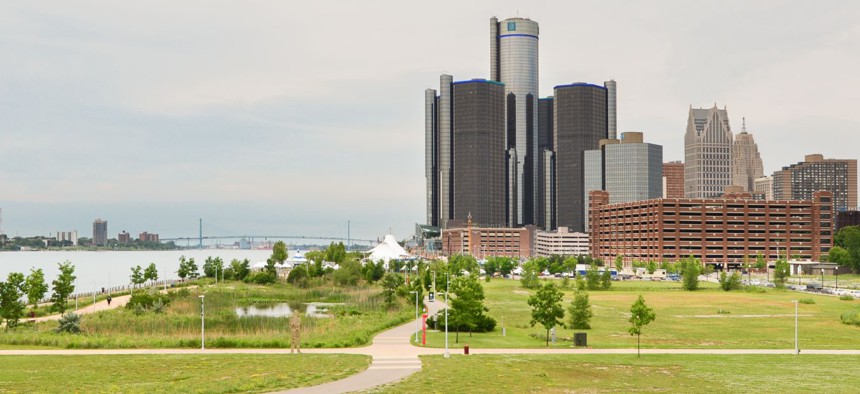Detroit Mini-Park Revitalization Project Looks to Improve Neglected Parcels

Detroit, Michigan Shutterstock
The Knight Cities Challenge awards 'Give a Park, Get a Park' proposal a major grant to better manage city resources and work with local property owners.
Revitalizing blighted vacant or public spaces was the most popular theme among the Knight Cities Challenge’s second-round winners, with applicants from Detroit proposing perhaps the most ambitious project.
The Motor City received a $75,000 Knight grant for Give a Park, Get a Park, the selling of side lots to residents only to develop more accessible, sustainable neighborhood mini-parks nearby.
Not to be confused with micro-parks, which are tiny, parking-lot-sized parcels, mini-parks are just under two acres and have fallen into neglect throughout Detroit.
“Agencies can’t afford to maintain them," Susan Burrows, director of Detroit's Planning and Development Department’s Office of Yes, told Route Fifty in an interview.
So local artist Zak Meers approached Planning Director Maurice Cox and, in conjunction with Parks and Recreation and General Services, created a plan to first offload burdensome public land.
The Detroit Land Bank Authority already has a side lot program permitting the sale of vacant, abandoned or foreclosed city space to adjacent property owners for $100. By giving up ignored mini-parks in that way, Detroit frees itself up to design more centrally located, easier to maintain parks meeting community needs with few spent resources.
Copenhagen, Denmark pioneered the idea, and on weekends families make their rounds of their favorite parks—each offering something different. One might be a hedge maze and another feature yoga.
Detroit has a year to aggressively engage neighborhoods, sell side lots and solicit designs from landscape architects in keeping with each area’s character and making use of existing amenities like streams. Only then will the city try and scale the model to other neighborhoods.
“The economic underpinning is that maintaining parks is a huge expense for any city,” Burrows said. “In design and execution the mini-parks would need to be sustainable—grasses won’t need to be mowed—so that the city isn’t trading one maintenance issue for another.
The city, which emerged from the nation's largest municipal bankruptcy in 2014, has limited resources and the city of Detroit is expansive, covering around 140 square miles. By land area, Detroit is larger than Manhattan, Boston and San Francisco combined. The city's population dropped from an all-time high of around 1.8 million residents in 1950 to under 1 million in the mid-1990s to under 700,000 following the Great Recession. As maintenance costs became too much for the city government to manage, many mini-parks reverted to vacant lots.
The city will study which of its approximately 10 target neighborhoods are best able to replace one park with another.
“Mayor Mike Duggan is convinced Detroit’s comeback is completely dependent on the comeback of its neighborhoods,” Burrows said. “Sustainable mini-parks help property values, save the city money on maintenance and are a place where neighbors can come together.”
Dave Nyczepir is a News Editor at Government Executive’s Route Fifty.
NEXT STORY: D.C.’s New 51st State Push; Waco vs. Its Wildflowers






